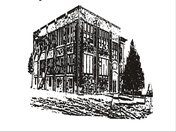
WYNOT SCHOOL HISTORY
The town of Wynot was established in 1907. At that time the town was in the original public school #10 district. During the 1907–1908 school year the old building at St. James was used. This building was built in 1879 and sold in 1966. Additional room was secured in Dr. Jones building. It was very inconvenient and soon it was clear that a new building was needed.
A petition was circulated for a $5000 bond to erect a building. It was defeated in June 1908. The new town voters were unanimous, but the St. James people didn’t feel it was necessary. Ten grades were represented between the two towns. In May 1909 a mass meeting was held to discuss the re-arrangement of schools in the district. In June 1909 a vote was taken to build a school in Wynot and dispose of the school at St. James. At that time a school site was accepted from the town site company. The district paid $1000 for this site. When a bond election was held in Sept., 1909 it was again defeated. After this the district was divided leaving St. James with the school house. In 1909 – 1910 school was still held at St. James and Wynot. Three students graduated from the tenth grade. The first school board consisted of D.E. Cook, F. A. Kindwall, and H. A. McCormick.
By the fall of 1910 all pupils of District 101 went to school in the Dr. Jones building and the building adjoining it. This was the first session of the entire enrollment of all pupils in District 101. Teachers included; Miss Hazel Jones, Miss Carrie Schmidt and Supt. F. O. Bindrup.
In 1911 the board was instructed by voters to erect a new school building, and provide the necessary funds. Some funds had been raised by a special building levy, but it was impossible to vote a bond of sufficient size to meet the need. Warrants were issued for the necessary funds. In Sept. 1911 a contract for a new building was awarded to J P Riddle of Creighton, who agreed to have the building ready by Jan. 1, 1912.
The 1911-1912 school term was again held in the two building located in downtown Wynot. The school house was completed forth 1912-1913 school terms at an investment of about $15,000. The school faced south, had a number of steps leading up to the front door and was complete with a large cupola and bell in the north half of today’s current building. In April, 1913 on Arbor Day, trees were planted around the school; each tree received a name as it was planted that day.
Teachers that taught in the new building were Supt. F.O. Bindrup, Miss Anna Stuckenhoff, Miss Hazel Jones, and Miss Kathryn Prescott. Ed Morris was hired as a janitor. There were 65 students that term. It should be noted there are no records of their being a school in Wynot from 1909 – 1913 in the Cedar county Supt. Office. Nor is there a record of students who attended.
The lack of a large building or auditorium curtailed indoor physical activities, but produced some excellent baseball teams. The Opera house was used for programs. It located a space above the Wynot Cash Store or Hackl’s Grocery Store. Too much activity would shake the gas lamps downstairs in the store.
The Methodist church was partially completed in 1922. Various activities were held in the basement. This large room had a floor for basketball, a stage for plays, speech contests and other programs. An inter-city competition for basketball for Wynot High was initiated. Wynot basketball teams were called Wynot Wildcats until 1946 when they became the Blue Devils. In 1957 the girls’ volleyball team was known as the Blue Angels.
In June 1924 the voters decreed that a 44’x90’ addition should be added to the south side of the old building. This was at the cost of $26,000. It contained a gymnasium-auditorium, a high school assembly room, several classrooms, a library on the west end of the upper hall and an office at the east end on the middle floor landing. The stage could be entered from the main auditorium floor or by a door on both sides. In 1926 the partitions of the stage were removed and the stage floor extended to the full width of the auditorium to provide more room at the sides of the stage and to permit wings to be set at an angle.
The 1926-27 terms saw the northwest corner of the basement divided into two rooms; one for a kitchen and the other for a lunch room. In Feb. 1940 a hot lunch program was set up by Mrs. George Chamberlain, Mrs. Lenora Macklem and Mrs. Theo Reiken serving 150 children daily. This lasted for two years. In 1953 the rooms were remodeled to house a woodworking shop class.
In 1925 a county wide P.T.A. was established by Miss Emma Schreen, the county superintendent. In 1957 a new P.T.A. was formed which was in place until 1968.
In 1926 the first Junior Senior banquet was held in the Lutheran Church parlor. The next year it was held in a private home. From then until 1962 it rotated among the three churches in town. From 1962-1964 it was held in the school. In 1965 the banquet was held in Omaha and the 1966 the banquet was located in Yankton, S.D.
In May 1961, a vote was taken to build 40’x80’ addition to the west side of the school to house a modern lunch room, shop building and kitchen. The cost was $37,500. The assembly was divided into a music room, library and a typing room. The office was moved to the old library-storage room on the west end of the upper hall. The old office on the landing was converted to storage.
The reason for remodeling was enrollment changed with opening and closing of parochial schools. The 1939 –1940 school year saw an enrollment of 179 students when Sacred Heart School closed. In 1943 the school enrollment dropped. In 1955 enrollment went up when 62 students enrolled, continuing to grow until 1962 when it topped at 192 students. In 1955 District 72 merged with District 101. In July, 1956 District 33, known as Bow Creek School, merged with 101 making it the largest district in the area in Cedar County. It then contained 37 sections. When more districts merged the sections increased to 60.
In 1960 one school bus was purchased to transport students to activities instead of using private cars. In 1962, two more buses were purchased and in 1965 a station wagon plus six bus routes were in operation.
The school newspaper was named the Why-Not Squeak, established in the 1930’s. In 1947 the paper became the Echo. The Echo also became the name of the school yearbook. The first yearbook was published under the name of School Daze and this was the class of Venita Yonke Arndt.
Vocal music records were achieved during a period of 1933-1937 when the school won first place among the classes for five years in a row. In May 1934 they won the first place sweepstakes in Lincoln in a music competition. Dr. C. C. Tellesen lost his life in an auto accident while taking students to the state music contest in 1934.
King and Queen of the school year were started in 1940. Leota Yonke and Lyle Gregerson were first couple named. In 1943 Darrell Gowery and Lorene Brewer were named the most popular couple. Since 1949 there has been a homecoming king and queen selected. Shirley Driver and Donald Schroder were the first couple to be honored. An Alumni Banquet has been held every five years since 1950.
In 1965 the first homecoming parade and football game were held. Mr. E. J. Carlson coached this first team. One year later a band was formed with 50 performing artists out of the 72 who participated in the instrumental program.
In Feb. 1968 voters considered the bond for the steel construction of a 120’x30’ two-story building that would provide space for seven elementary classrooms, kindergarten through sixth grade, and a regulation-size gym. At the end of the gym was a 25’x50’ stage. Two locker rooms, a music room and storage space, office room and a meeting room for the board of education were included in the stage area. The cost would break down to $9.00 per square foot. Funds included in this bond were to convert the old gym into a new science room, home economics room, library and commercial room.
The gym and conversion costs were included in a bond that passed. An attached music room located on the west side of the gym was built and is still in use today.
In June 1968, voters approved a $65,000 bond to build a 70’x84’ steel gymnasium, four elementary classrooms, boys and girls bathrooms and a storage room. This building adjoined the kitchen and shop area of the current building.
In the 1970’s, consolidation was an option for the Wynot School. It was decided not to pursue this but it was an issue that was revisited several times in the next few years.
The 1986-87 school year moved to a four-day week schedule. This was done to save the district money. There are very few schools that practice this, but later schools came to see how we did this and copied our efforts. The days are longer, and the school does have some five-day weeks in the fall and in the spring. Cost savings included utilities, bus service, staff and other items.
In the fall of 2007 Wynot Public Schools entered into an inter-local agreement with three local schools: Newcastle, Coleridge and Laurel-Concord. The schools share teachers, a Superintendent and resources, but each maintains its own identity and budget. The students were allowed to choose from over 60 Distance learning classes this school year.
New bleachers were purchased in 2012 and installed in the gymnasium.
